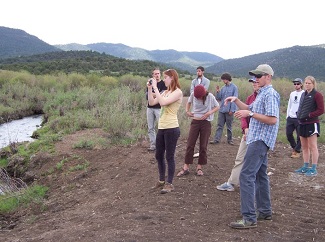The Colorado Parks and Wildlife Commission announced the upper Arkansas River as the newest addition to the statewide list of Gold Medal Trout Waters. The new Gold Medal reach is 102 miles long from the confluence with the Lake Fork of the Arkansas River, near Leadville, downstream to Parkdale at the Highway 50 bridge crossing above the Royal Gorge. This one remarkable listing doubles the extent of Gold Medal river miles recognized in Colorado. Once a poster-child for the adverse water quality impacts on rivers left behind by our state's legacy of mining, the Arkansas now "officially" joins the ranks of Colorado's elite, high-quality trout waters.
The Gold Medal designation has been 20 years in the making, and although anglers have enjoyed the improved conditions for years, it is an official acknowledgement of the great success of myriad efforts undertaken by government agencies, nonprofit organizations, and other partners to turn an impaired river into one of the most popular fishing destinations in Colorado.
Colorado Trout Unlimited's Collegiate Peaks Anglers chapter has been an active partner in conservation efforts along the Arkansas throughout this time. From habitat improvement efforts in the basin, to assisting with mine cleanup efforts (including ongoing efforts with National TU's Abandoned Mine Program on the Tiger Mine), to helping acquire new public access - TU has a long history of involvement with the river. The new Gold Medal designation, as well as Senator Mark Udall's proposal to establish a new National Monument along the Browns Canyon section of the Arkansas, are testament to the benefits of many years of hard work. The Arkansas River is also a model for cooperation - with many agencies including EPA collaborating to improve its water quality, a multi-agency collaborative managing the "Arkansas Headwaters Recreation Area" with tremendous boating and fishing opportunities, and a partnership with water users for cooperative releases to maintain whitewater recreation during the summer and needed stable fish flows in the fall and winter.
“The upper Arkansas River fishery is the best it has been in over a century thanks to the efforts and hard work of many agencies and individuals that have recognized its great potential,” said Greg Policky, Colorado Parks and Wildlife Aquatic Biologist. “I am very pleased that this outstanding river has received the Gold Medal designation and is now ranked among the elite trout fisheries in Colorado.”
Gold Medal listings are a reflection of a healthy trout population accompanied by strong numbers of larger fish. In order to receive a Gold Medal listing, a body of water must consistently support a minimum trout standing stock of 60 pounds per acre, as well as consistently support a minimum average of 12 "quality trout" – trout larger than 14 inches – per acre.










